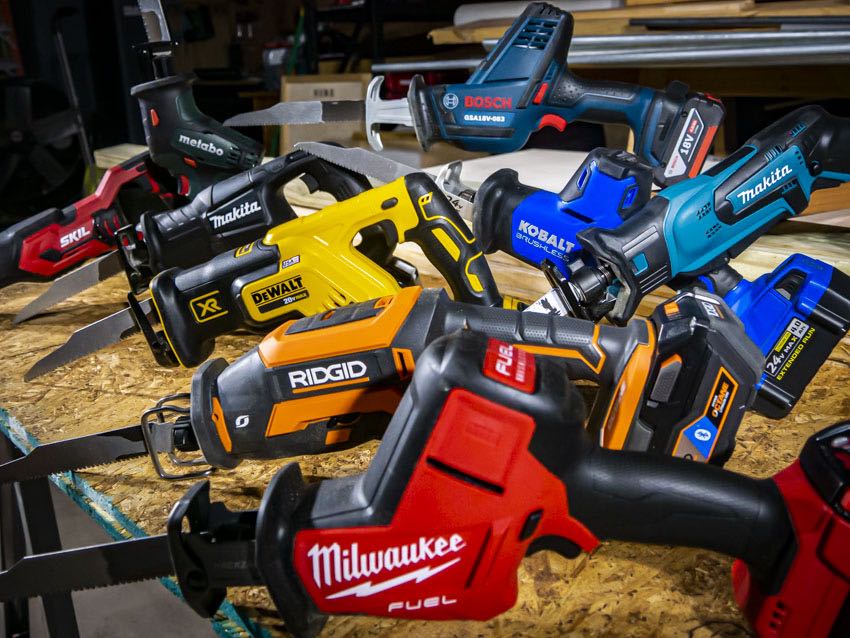Our search for the best compact cordless reciprocating saw led us to two distinct categories: two-handed and one-handed. Often called by the Milwaukee Sawzall proprietary reciprocating saw name, these two classes of saws represent the most comfortable cutting experience, trading off cutting speed and power for lighter weight and less vibration.
Two-handed models are more closely related to standard saws. They sometimes shift from an inline design and angle the secondary handle down in a shorter design that can more easily reach into tight spaces.
One-handed compact cordless reciprocating saws share a common design where the motor turns up from the body, shortening the overall length but without as much effect on the overall height. These models are a great choice for HVAC, plumbers, irrigation specialists, electricians, and even landscapers for pruning.
Between the two, we expect higher performance from the two-handed saws and a more comfortable cut from the one-handed group.
Editor’s Note: Be sure to also check out our best 12V reciprocating saws article.
Best Compact Cordless Reciprocating Saw: Two-Handed Models
Makita 18V LXT Brushless Sub-Compact Reciprocating Saw
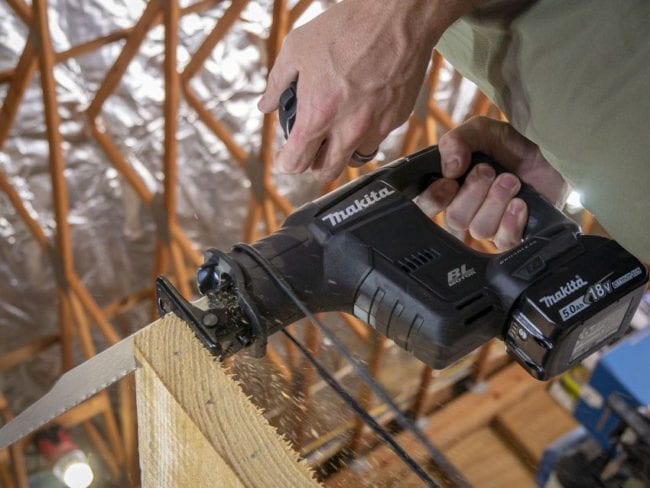
Makita’s Sub-Compact reciprocating saw dominated the two-handed group. It cut slightly slower than DeWalt’s compact model and has a clear advantage in vibration control and overall size. When you need solid cutting performance in tight spots, Makita is your go-to compact saw.
Best Compact Cordless Reciprocating Saw: One-Handed Models
Milwaukee M18 Fuel Hackzall
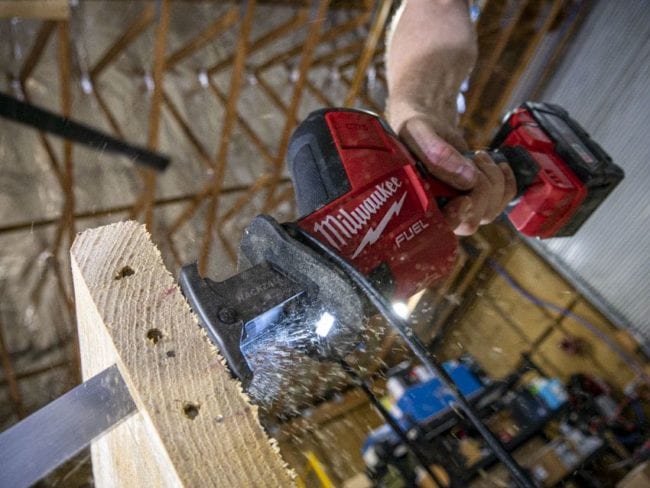
Milwaukee M18 Fuel Hackzall takes a close win over Kobalt’s 24V one-handed reciprocating saw. Milwaukee Tool’s major advantage comes in vibration control, while Kobalt is a little smaller and a bit better on the value side.
Best Compact Cordless Reciprocating Saw Cutting Speed
Two-Handed: DeWalt 20V Max Brushless Compact Reciprocating Saw
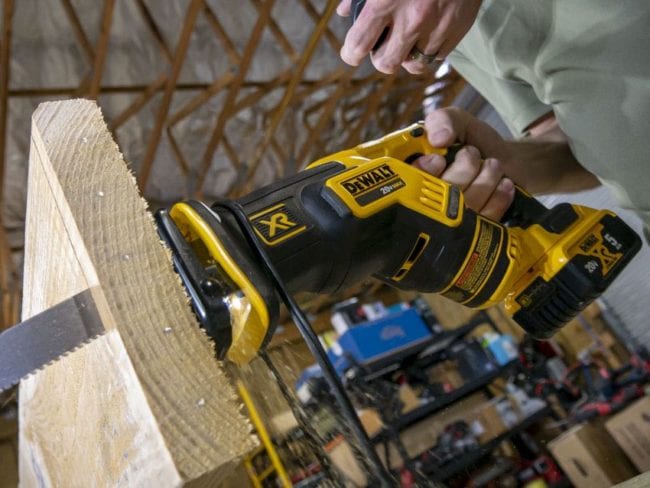
DeWalt put together a beast of a compact reciprocating saw with the DCS367, making it the fastest cutter in its class. What it gains in speed, it loses in vibration control, however. With Makita right on its heels for speed, it’s a trade-off you’ll want to carefully consider.
One-Handed: Ridgid 18V Octane Brushless One-Handed Reciprocating Saw
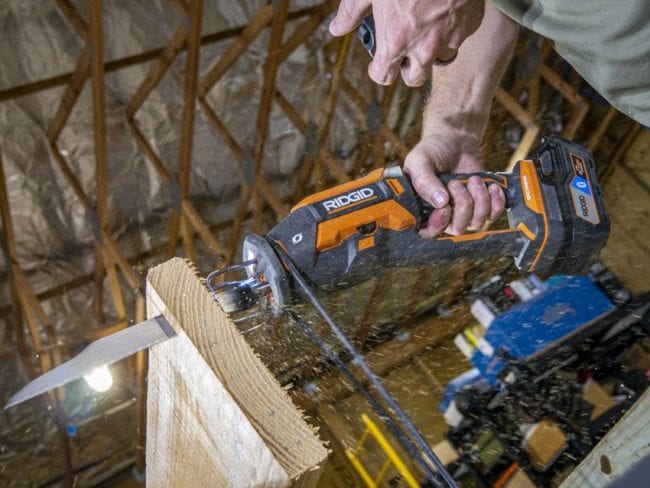
Ridgid’s Octane one-handed reciprocating saw put on a clinic in our speed tests, coming out on top. As the only compact reciprocating saw in either class that includes orbital action, Ridgid clearly doesn’t want you to be limited to cutting just EMT and PVC.
Best Compact Cordless Reciprocating Saw Vibration Control
Two-Handed: Makita 18V LXT Brushless Sub-Compact Reciprocating Saw
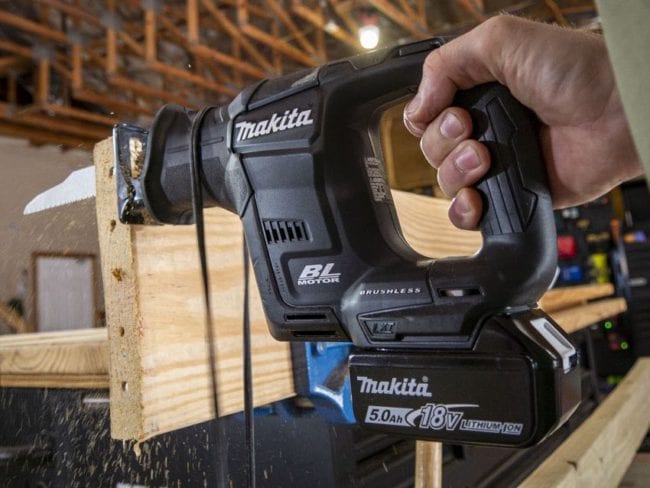
When you use a compact reciprocating saw, you’re usually cutting in places that are less than ideal. That makes vibration control even more important. Makita takes full advantage of this with a significant lead in the two-handed class.
One-Handed: Milwaukee M18 Fuel Hackzall
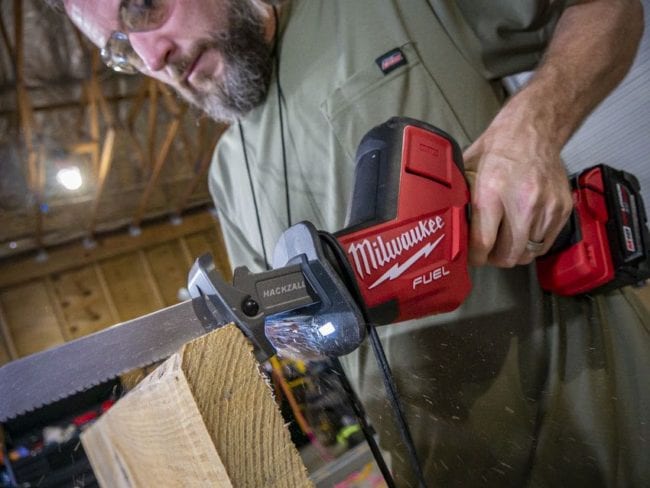
If you’re going to use a reciprocating saw with just one hand, it better not vibrate the feeling out it! Milwaukee seems to get this better than anyone else in the one-handed class, making their M18 Fuel Hackzall one of the most comfortable to use.
Most Compact Cordless Reciprocating Saw
Two-Handed: Makita 18V LXT Brushless Sub-Compact Reciprocating Saw
Makita finishes with a slight advantage over Skil in the overall size race. Skil has the weight advantage, better than 1.5 pounds lighter than Makita. Makita has the advantage with a length that’s nearly 4″ shorter than Skil and close to an inch shorter than DeWalt.
One-Handed: Metabo 18V One-Handed Reciprocating Saw
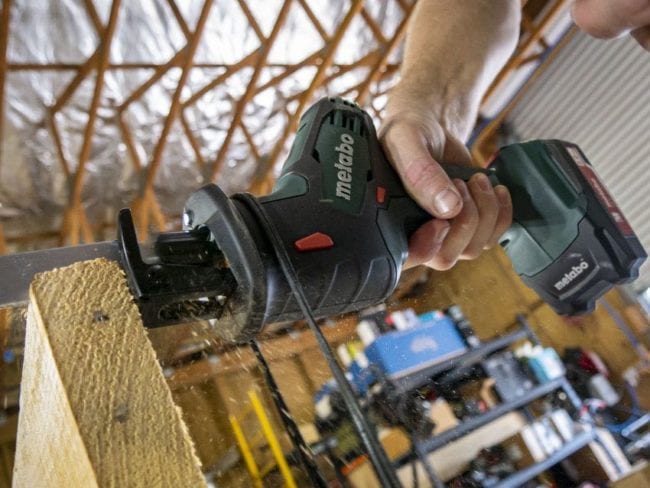
The one-handed class is much simpler to sort out—Metabo’s model is both the lightest and shortest. It has a little competition from Makita on the weight and healthy advantage over the entire field in length.
Best Compact Cordless Reciprocating Saw Value
Two-Handed: Skil 20V Compact Reciprocating Saw
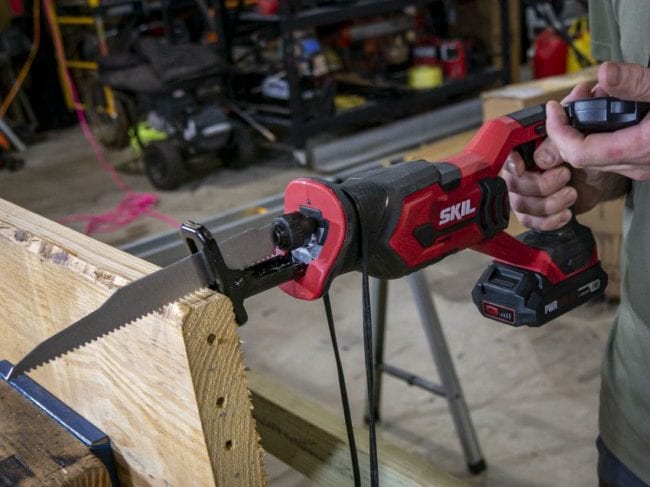
It’s no surprise to find Skil at the top of the value rankings. In the two-handed class, they crush the competition with a $79.99 bare tool and $89.99 one-battery kit. You give up higher cutting speeds, but its competition is nowhere near that low of a price.
One-Handed: Kobalt 24V Brushless One-Handed Reciprocating Saw
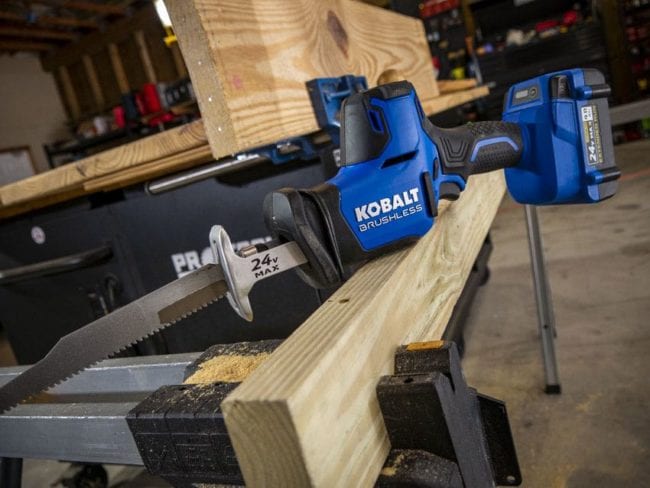
Kobalt’s 24V line has been quietly impressing us with its performance across the board. Their latest pricing structure also makes them an outstanding value. The 24V one-handed reciprocating saw continues the trend with excellent performance and a $99 bare tool price. If you’re not already on Kobalt’s battery system, a 4.0Ah battery and charger will run a little over $100 more.
Best Compact Cordless Reciprocating Saw: How We Tested and Full Results
Cutting Speed
Two-Handed Models
We tested these two classes of saws a little differently based on what they’re designed to cut. In all of our cutting speed tests, we used a 5-pound weight to ensure each saw got the same amount of downforce. For the two-handed model, we took an average of how long it takes to cut through pressure-treated 2 x 10 pine with five 16D galvanized nails embedded within.
Each saw got a brand new Lenox Demolition CT Carbide Tipped Blade to start with. These 6 TPI blades last up to 6x longer than standard Lenox bi-metal blades in nail-embedded wood and their thick profile helps stabilize the cut. You can pick them in 6″, 9″, or 12″ lengths from your favorite Lenox retailer.
DeWalt has the fastest average cutting speed in nail-embedded wood followed closely by Makita.
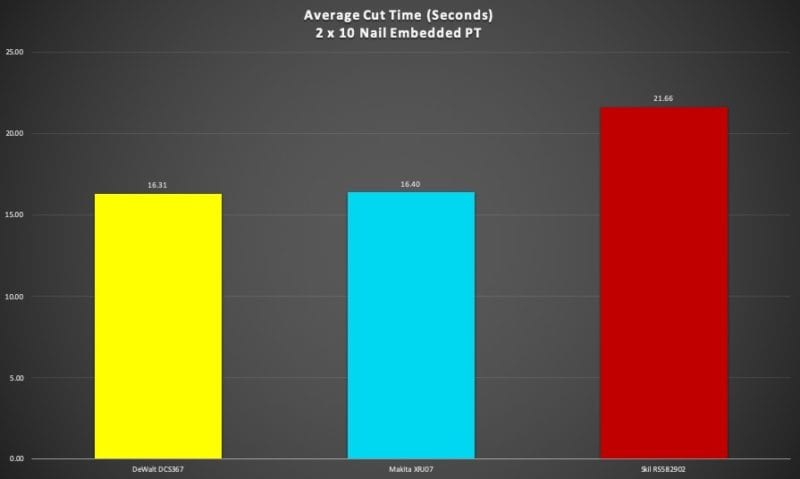
The second test for the two-handed class was cutting 3/4″ EMT. For this one, we turned to Lenox Lazer 18 TPI medium metal bi-metal blades for 1/16″ – 1/4″ cutting. Their taller cutting profiles make more stable cuts and Power Blast design increases the overall life of the blade by increasing its strength. They’re available in 6″, 9″, or 12″ lengths.
DeWalt enjoys a little bit of breathing room over Makita in EMT cutting.
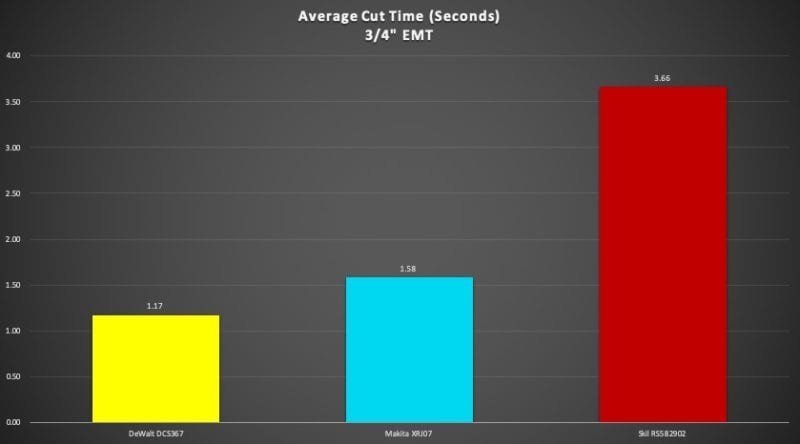
One-Handed Models
For the one-handed saws, we used the same 3/4″ EMT test and added 3″ PVC cutting. We used Lenox Lazer 18 TPI blades for both tests.
It’s intentional that we didn’t use a wood-cutting test for these. They’re primarily plumbing/electrical/irrigation tools and are generally not great wood cutters. However, they’re great around the yard with a pruning blade as an easier and safer alternative to a chainsaw for some cuts.
Kobalt and Ridgid set themselves apart as the only one-handed saws to break 2 seconds in our EMT cutting test.
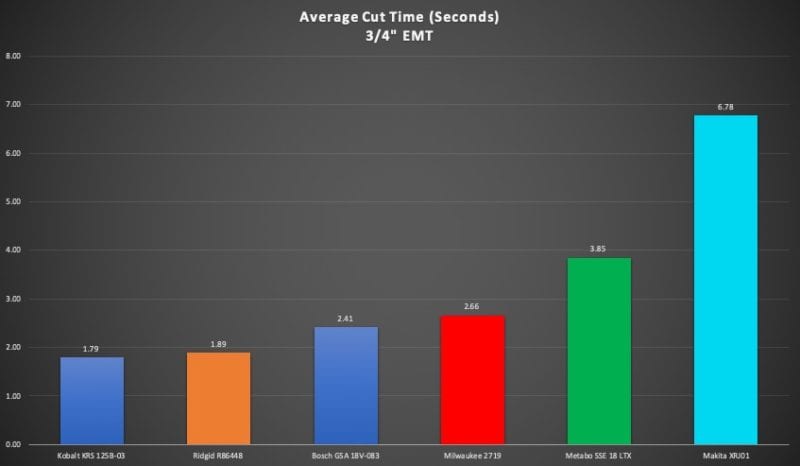
Ridgid takes over the lead from Kobalt in PVC cutting where it gains nearly a full second advantage on average. Bosch sneaks in ahead of Kobalt to take second place in this test.
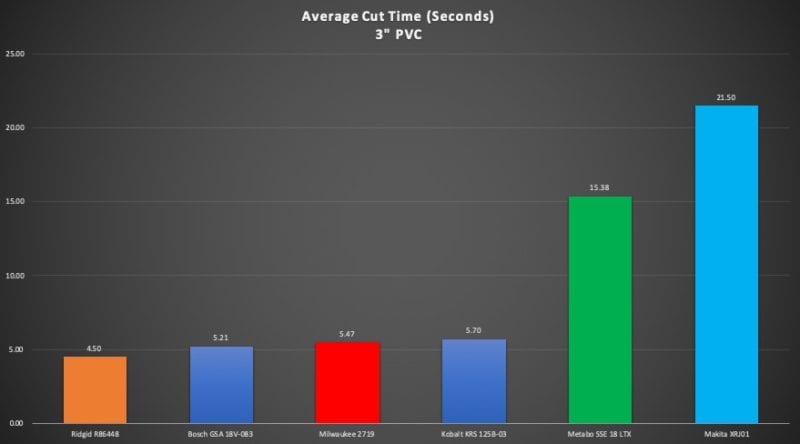
Vibration
Vibration ended up being a more subjective test. With all of our test materials available, we sent out a team of three (Tom Gaige, Clint DeBoer, and myself) one at a time to cut to their heart’s content. Each tester then ranked each compact reciprocating saw on a 1–4 scale. Once each of us had our results without the influence of the others, we tallied them up and averaged them out.
The higher the number, the better the vibration control.
Makita enjoys a big advantage over Skil in the two-handed class with both outclassing DeWalt.
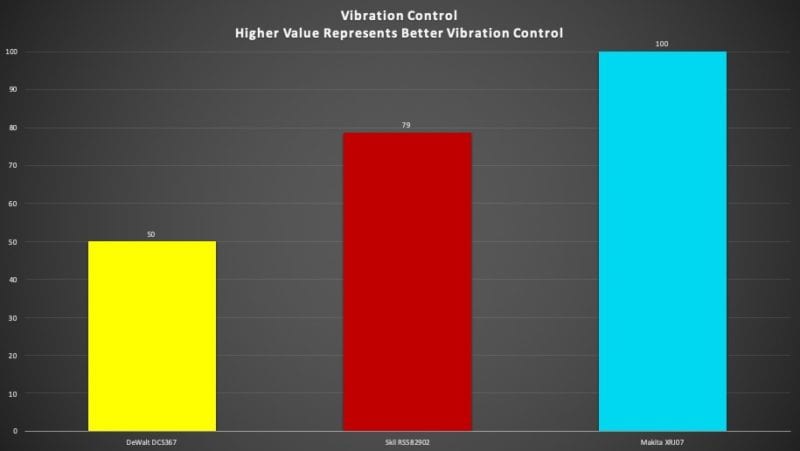
For the one-handed saws, things were a little closer, but Milwaukee still had a significant lead over the rest of the field. Bosch made a strong showing in second, scoring a very respectable 87 points.
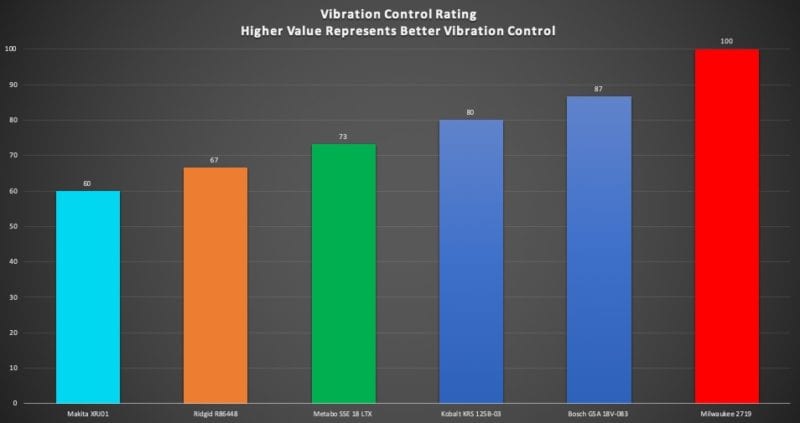
Feature Set
Generally speaking, the more compact you get in the cordless reciprocating saw game, the less emphasis we see in features. Here’s what we look for across the board and which models have them:
Brushless Motor
- DeWalt DCS367
- Makita XRJ07
- Kobalt KRS 125B-03
- Milwaukee 2719
- Ridgid R86448
Orbital Action
- Ridgid R86448
Variable Speed Dial
- None, though all models have a variable speed trigger
Pivoting, Tool-Free Adjustable Shoe
- DeWalt DCS367: Pivoting only
- Makita XRJ07: Pivoting only
- Skil RS582902: Pivoting, adjustable (tool required)
- Makita XRJ01: Adjustable (tool required)
- Metabo SSE 18 LTX: Tool-free adjustable only
- Milwaukee 2719: Pivoting only
Lever Blade Release (Not a Shaft Twist Lock)
- DeWalt DCS367
Rafter Hook/Belt Hook
- None
LED Light
- All models have an LED light
Spring Blade Ejection
- Makita XRJ07
- Makita XRJ01
Smart Controls
- None
Additional Design Notes
DeWalt DCS367
On both this model and DeWalt’s standard 20V Max reciprocating saw, DeWalt has 2 blade lock positions. You can install your blade in either direction in both slots, giving you 4 total directions to work without turning the saw.
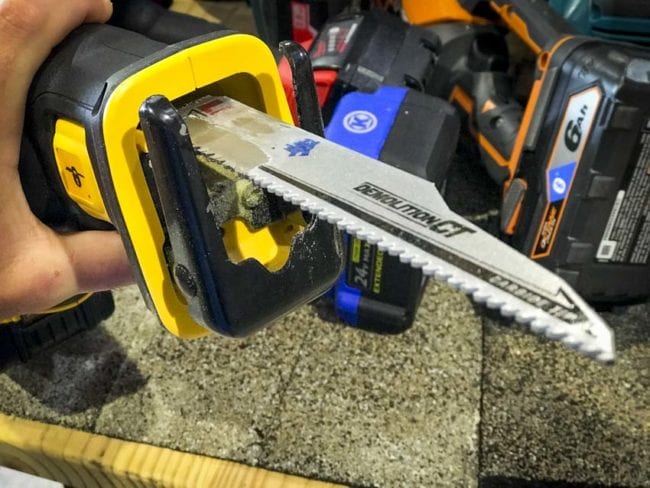
Skil RS582902
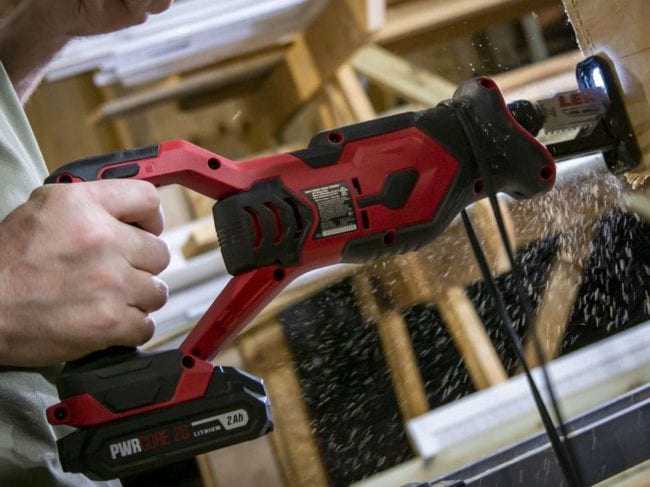
While DeWalt and Makita go for a kind of “squashed” design to make a short length and taller height compact reciprocating saw, Skil’s model is a traditional inline model on a smaller scale. It’s very lightweight and easy to wield if you’re looking for a more manageable form of a traditional design.
Makita XRJ01
Makita’s XRJ01 doesn’t look anything like most of the one-handed reciprocating saws in our test. Its inline foundation angles down to shorten the length while its combination of triggers gives you a ton of flexibility in how you use it. Our team greatly prefers the “choked up” one-handed position closer to the blade.
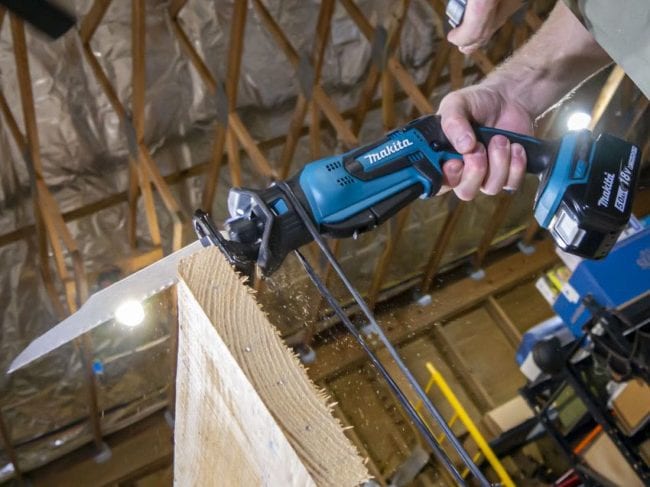
The main handle design makes it tough to engage the safety and trigger with one hand. We often have to start the motor with two hands or shift our grip.
Metabo SSE 18 LTX
In addition to its tool-free adjustable and removable shoe, Metabo also created a blade lock that’s designed to accept jigsaw blades. It can be pretty handy in a pinch.
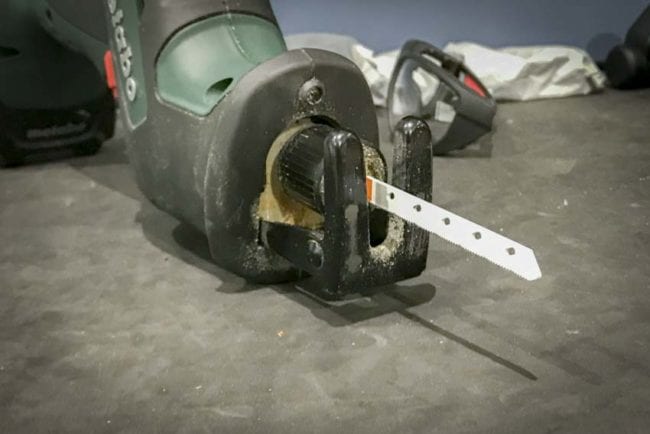
Ridgid R86448
Ridgid has an interesting look for its one-handed saw with a hand guard in front of the trigger and a strong steel wire form shoe. It’s unique and it works for this class.
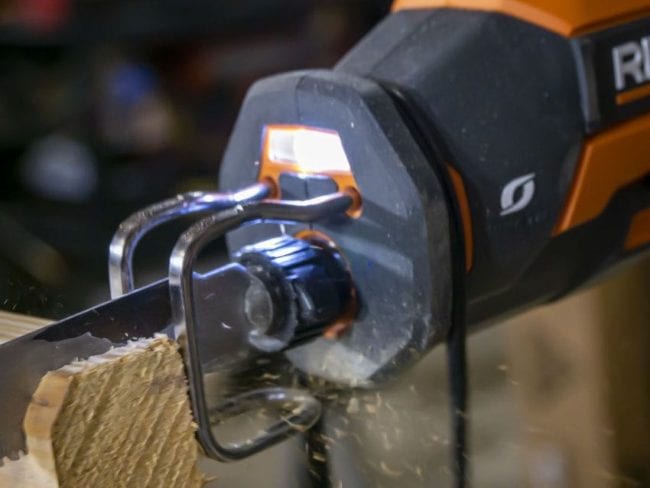
Size and Weight
For some people, “compact” makes them think smaller for fitting in tighter spaces while others think lightweight.
For two-handed compact reciprocating saws, you won’t find many shorter than Makita. At just 12.375″ in length, it’s not just the shortest two-handed model, it’s shorter than any of the one-handed models, too! DeWalt’s less than an inch longer, making it another excellent choice when you’re space-limited.
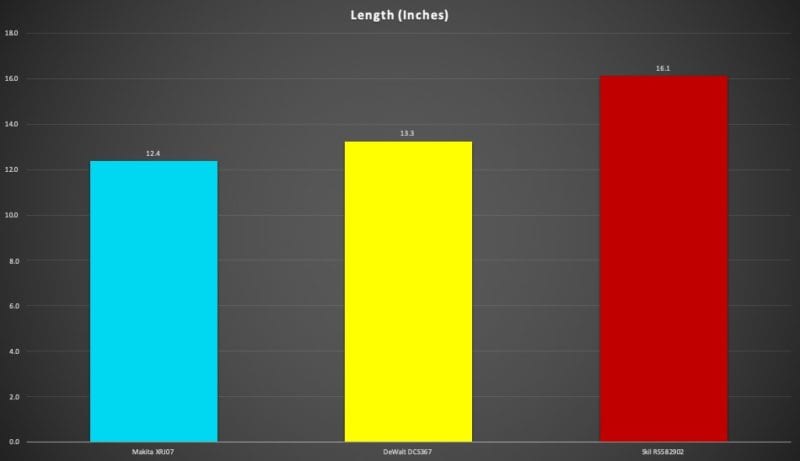
If lightweight is more what you’re looking for, turn to Skil. Their 20V compact model weighs 1.5+ pounds less than its other two-handed competition.
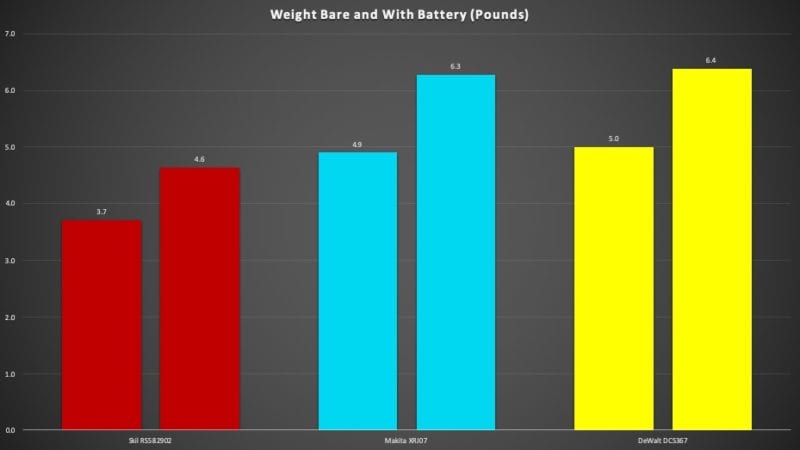
Both one-handed categories are led by Metabo. For length, it has a little breathing room over Kobalt’s 5/8″ longer design. Only Milwaukee joins them in breaking the 14″ mark.
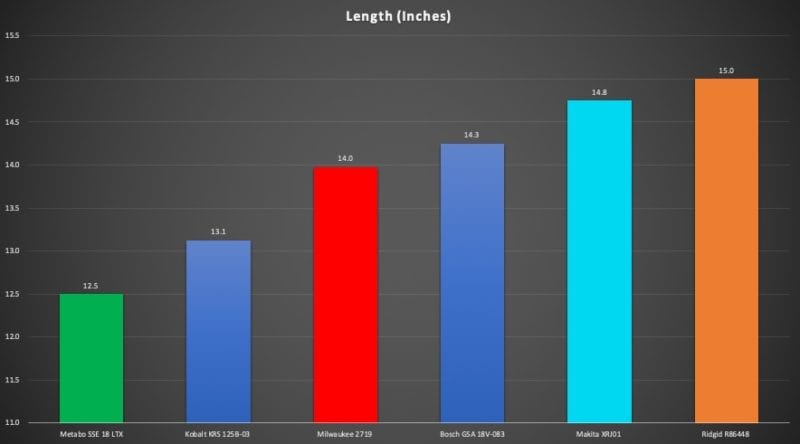
Metabo has some competition in the weight race, with Makita just 0.1 pounds heavier with a battery. Makita is actually lighter as a bare tool and it boils down to using a 2.0Ah battery for Metabo and a 5.0Ah battery for Makita. If you go with a compact battery and sacrifice runtime, Makita is the lighter option.
*Note: we used the battery kitted or recommended by each manufacturer.
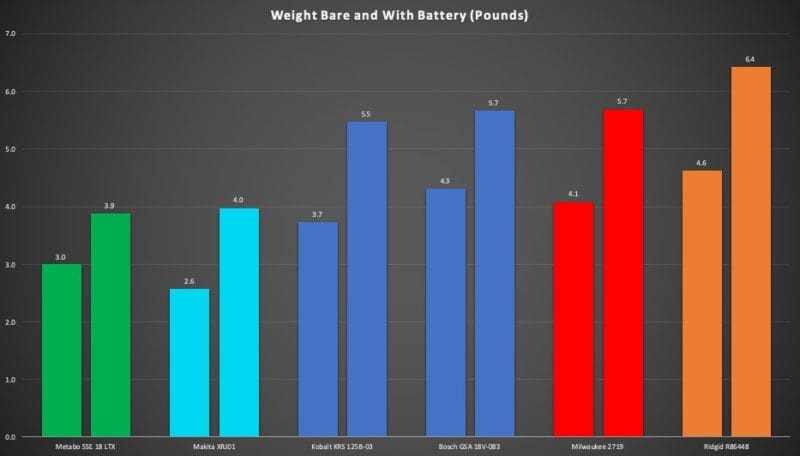
Value
Take the pricing, performance, and features and toss them in our magical algorithm with things like warranty and depth of line, and you get what we call “Value” at Pro Tool Reviews. It goes much deeper than just price.
For the two-handed models, Skil’s price is so much lower than DeWalt and Makita that it earns the highest value even though it has a much lower cutting speed. While DeWalt and Makita both score lower in value, they’re both worth considering.

If you’re looking for the best compact cordless reciprocating saw value in a one-handed design, Kobalt is the way to go. Their 24V line is quietly performing very well, and their latest pricing structure makes it an awfully attractive line to jump in for budget-minded Pros and DIYers. Bosch isn’t far behind and presents a good value as well.
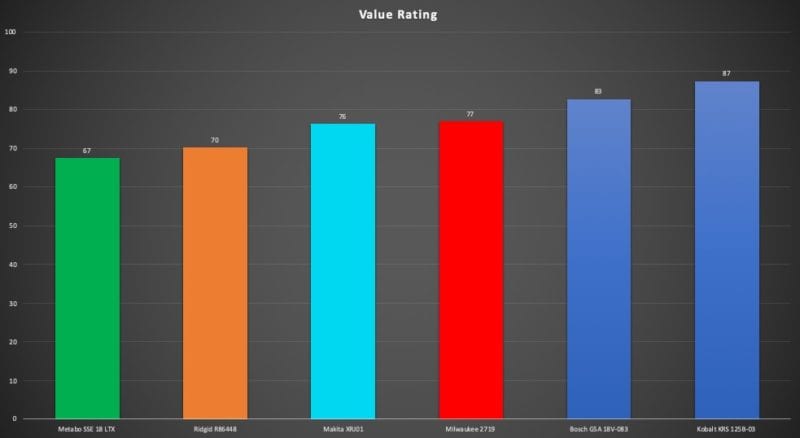
Price List
Two-Handed
- DeWalt DCS367: $179 bare, $239 kit with one 2.0Ah battery (Buy it on Amazon)
- Makita XRJ07: $149 bare, $219 kit with one 2.0Ah battery (Buy it on Amazon)
- Skil RS582902: $79.99 bare, $89.99 kit with one 2.0Ah battery (Buy it on Amazon)
One-Handed
- Bosch GSA 18V-083: $119.99 bare, $199 kit with one 4.0Ah battery (Buy it on Amazon)
- Kobalt KRS 125B-03: $99 bare tool only (Buy it at Lowe’s)
- Makita XRJ01: $99 bare, $267.68 with two 5.0Ah batteries (Buy it on Amazon)
- Metabo SSE 18 LTX: $129 bare tool only (Buy it at Acme Tools)
- Milwaukee 2719: $159 bare, $269 kit with one 5.0Ah battery (Buy it at Acme Tools)
- Ridgid R86448: $129 bare, no Octane kits available, $129 kit with one 5.0Ah battery and no charger (Buy it at Home Depot)
Best Compact Cordless Reciprocating Saw Final Rankings and Recommendations
Two-Handed Models
- Makita 18V LXT Brushless Sub-Compact Recipro Saw – Excellent cutting speed, vibration control, size, and feature set. Good value.
- DeWalt 20V Max Brushless Compact Reciprocating Saw – Top cutting speed, excellent feature set, good size. Struggles in vibration control.
- Skil 20V Compact Reciprocating Saw – Top value, lightest weight, good vibration control. Basic feature set and slowest cutting.
One-Handed Models
- Milwaukee M18 Fuel Hackzall – Excellent cutting speed and top score for vibration control. Good value.
- Kobalt 24V Brushless One-Handed Reciprocating Saw – Top value with excellent cutting speed, good overall size, and good vibration control.
- Bosch 18V One-Handed Reciprocating Saw – Excellent cutting speed and very good vibration control with a good value score.
- Ridgid 18V Brushless One-Handed Reciprocating Saw – Top cutting speed with a good feature set and unique design. Struggles with vibration control and size in this class.
- Metabo 18V One-Handed Reciprocating Saw – Most compact in size and weight. Struggles in cutting speed and has a pretty basic feature set.
- Makita 18V LXT Recipro Saw – Excellent size and good value with a unique multi-trigger design. Slowest cutting and struggles with vibration control.
Why Compact Cordless Reciprocating Saws?
Compact cordless reciprocating saws get you into spaces that standard models are too big to fit. In some cases, they’re also easier for DIYers to use as a primary option.
Two-handed models are great for squeezing between studs and working around equipment or installs that get in the way of longer models. They typically work well on metal, PVC, wood, and more.
One-handed models get you into even more awkward spaces. They can help you reach around under sinks, and around HVAC ductwork and equipment. They’re incredibly useful for irrigation and electrical where you need to hold the material with one hand to stabilize it and cut with the other. We also use them frequently with pruning blades up for landscaping duties where we would normally reach for a 12″ chainsaw.
Save for use with a pruning blade, most one-handed reciprocating saws are good for metal and PVC cutting, but only thin wood.
Why You Can Trust Pro Tool Reviews
At Pro Tool Reviews, we have our finger on the pulse of the tool industry. We’ve been in business since 2008 covering tools, writing reviews, and reporting on industry news in the commercial and residential construction industry. Our Pro reviewers work in the trades and have the skills and experience to know whether tools can perform well in the field.
Each year, we bring in and review more than 250 individual products. Additionally, our team will put our hands on hundreds of additional tools at media events and trade shows throughout the year.
We consult with innovators in the technology and design of tools to gain a broader grasp of where these products fit and how they work.
We work with more than two dozen professional contractors around the United States who review products for us on real job sites and consult with us on testing methods, categories, and weighting.
We’ll provide more than 500 pieces of new content this year absolutely free for our readers—including objective evaluations of individual tools and products.
The end result is a testing design you can trust because of the editorial, scientific, and real-world professional experience we collectively utilize each and every time we pick up and test a tool.

